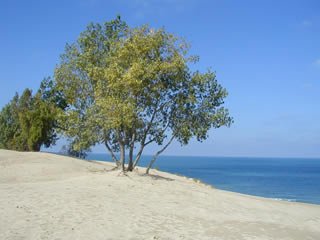John Bartlow Martin was born in 1914 in Hamilton,
Ohio, to John W. and Laura Martin. When John was a young child
his family moved to a residence on Brookside Avenue in Indianapolis.
He grew up in this rough part of the city, which had a distinct
impact on his style of writing—a focus on the underprivileged
members of society. Eventually he completed a degree at DePauw
University in Greencastle,
Indiana, and pursued a job as a reporter.
Martin's contemporaries considered him "the
best living reporter" in America, and his articles were
set apart by their deep concern for the "common man."
His work frequently appeared in magazines such as Saturday
Evening Post, Life, Look, Colliers, Atlantic Monthly, Reader's
Digest, and Harper's. Four years consecutively
he won the magazine publishing industry's highest honor, the
Benjamin Franklin Award. His successful career in journalism
led him to such endeavors as a speechwriter and adviser for
the presidential campaigns of John F. Kennedy, Robert Kennedy,
Lyndon B. Johnson, and others. These connections also led
to a position as the U.S. ambassador to the Dominican Republic.
The
work most significant to the topic of natural Indiana is Indiana:
An Interpretation, published in 1947. Martin
spent a great amount of time traveling the state digging up
information and interviewing everyone from politicians to
homemakers. He states in the preface to the book:
The purpose of this book...is to interpret
a state, Indiana, and the people who inhabit it.... This
book is not history; it is journalism. It is one man's interpretation
of Indiana—that is the Hoosier character, the Hoosier thought,
the Hoosier way of living. (vii)
His portrayal of Indiana's natural world is shown
through his investigation of historical accounts, specifically
the effects that the land had upon the people. Martin writes
of Indiana's pioneers and their relationship with the natural
world:
At the end of the long journey from the East,
over the mountains or down the rivers,
across broken hills and dismal forests
and prairies
covered with head-high grass, lay only forest to settle
in. And after the trees were cut
and the cabin built and the brush cleared and the stumps
uprooted and the rails split and the rail fence built and,
at long last, the earth broken with the plow and the first
crop gathered.... This was the place where a man could come
with nothing but his hands could clear the forest and build
a home and, build a fortune. (33, 37)
Martin presents the Indiana wilderness as a very
harsh and dire place until the pioneer settled it by manipulating
nature to his own needs. These things had to be done, Martin
states, for the settler to even consider the land his own
property. The natural world was valued only for the ways it
could directly benefit civilization, as in this example from
the northern town of Yellowbank:
True, the wild pigeons no longer roosted up
at Yellowbank so thick that they broke the tree limbs, but
there were still plenty of squirrels and quail, and any
farmer could put a net across a stream and get a wagonload
of fish. (90)
The population of passenger
pigeons, once numbering in the billions, was already diminishing
during the settlement of Indiana in the mid-1900s; other animals,
however, were considered endlessly abundant food sources.
Martin saw change as a progressive and positive,
including the urbanization
of Indiana:
Many farmers were moving to the hamlets, and
hamlet dwellers were moving to the towns, and townsfolk
were moving to the cities. Every town felt a great yearning
to be called a city. (89)
The strong attraction of industrialization held by earlier
Hoosiers was clearly felt by Martin himself:
Up at Whiting, a tiny hamlet in the Calumet
district, Standard Oil built the world's largest refinery,
the first step in transforming desolate dunes
and swamps
into Indiana's greatest industrial region, and one of the
nation's greatest. (89)
 |
| The Sand
Dunes at Lake Michigan |
Like so many Hoosiers of the time, Martin thought
it wise to transform the "waste land" of northwest
Indiana into useful industrial development. He failed to recognize
what many modern Hoosiers have realized: that the "desolate
dunes" and swamplands are valuable for their ecological
diversity and place in the habitat systems of northwest Indiana.
Besides, they possess unique beauty and make great recreation
areas.
John Bartlow Martin's views of Indiana are, as
he stated himself, "one man's interpretation," but
they reflect widely held opinions of Indiana's natural environment
at the time he writes about. Many Hoosiers have since realized
the value of conserving and preserving the state's natural
assets. We can only speculate that Martin today might have
different opinions as well.
Sources:
Boomhower, Ray. "A
Voice for Those from Below." Traces 9.2 (1997):
4-13.
Martin, John Bartlow.
Indiana: An Interpretation. New York: Knopf,
1947.
Image:
Boomhower, Ray. "A Voice for
Those from Below." Traces 9.2 (1997): 4.
|




